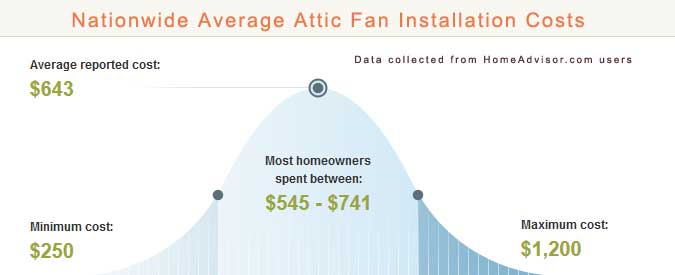Last Updated: February 14, 2023
Cost to Have an Electrician Install an Attic Fan
Try Our Free Electrician Cost Calculator
Fill out our 30 second free form to receive competitive pricing from pre-screened electricians. No commitments. Our service is always free!
Attic temperatures can reach up to 150 degrees, and heat from the attic accounts for about 20 percent of the average homeowner’s cooling costs. Having an attic fan installed is a great way to regulate temperatures, ensure proper ventilation and protect your home from damage.
Attic fans work by drawing in cooler air from outside and pushing hot air outside. Specifically, the benefits include:
- Lower AC costs - Attic fans save money and improve your home’s energy efficiency in the summer months by cooling hot attics. Your AC system doesn’t have to work as hard.
- A longer-lasting roof - Fans prevent heat and excess moisture from causing structural damage to your roof. The warranties that cover roof shingles usually require proper attic ventilation.
- Better ventilation - Fans remove unwanted gases and odors from your attic.
- Prevention of ice dams - When your attic is not properly vented, heat from the attic can melt snow on the roof, causing water to flow under the roof and freeze. Eventually, ice accumulates and prevents additional snow melt from draining, which leads to damage such as leaky roofs, ceilings and walls.
- Reduced moisture - Attic fans help prevent condensation, which can lead to damage, rot, mold and mildew. They also protect items you have stored in the attic from moisture damage.

Types and Installation
There are two basic types of attic fans: wall mounted or roof mounted. Wall-mounted fans tend to be easier to install because there’s no need to remove any roofing material. And in some cases, they can be installed in place of an existing wall vent. With roof fans, a hole is cut through shingles and the roof, the fan is installed, and then the contractor shingles around the fan. Roof fans typically need to be mounted on a base of plastic or sheet metal.
All attic fans require some sort of power source. Most are powered by your home’s electrical supply (which is why you need to hire an electrician when installing one), although some run on solar power. Most fans are thermostatically controlled, meaning they turn off and on as needed, but some are manual. Often, attic fans have humidistats in addition to thermostats to control the attic’s humidity.
Some people hire an electrician to handle the complete install. Other people hire an electrician for the wiring and then a handyman or contractor to do the installation. In other cases, a roofing contractor handles the job from start to finish, hiring an electrician as a subcontractor.
Try Our Free Electrician Cost Calculator
Fill out our 30 second free form to receive competitive pricing from pre-screened electricians. No commitments. Our service is always free!
Cost to Install an Attic Fan
Installing a new, electric-powered attic fan in an existing home usually costs $400 to $700. This includes the fan, labor and a thermostat. The price varies based on the type and size of the fan, the complexity of installation and local labor rates.
Electric-powered attic fans range in price from about $100 to $400 (not including installation), while solar fans typically cost $300 to $600. However, because solar fans do not require electrical wiring, the total cost after installation is usually not too much more expensive than with electric fans. A humidistat usually adds $75 to $150 to the total purchase price.
Installing a new electric fan while your roof is being replaced is usually much cheaper, ranging from about $200 to $400. Replacing an existing electric fan with a new one tends to cost anywhere from $200 to $400 (may or may not include the fan).
Choosing an Electrician and/or Contractor
Your contractor or electrician will be able to help you choose the right type and size of fan, as well as the right placement and features. But how do you know you’re choosing the best installer? Here are some tips.
- Get quotes from several local companies (electricians and contractors) to compare prices. Throw out any bids that come in unusually high or low. Companies with middle-of-the-road bids usually offer the best bang for your buck.
- Make sure the electrician or contractor is licensed. Ask to see a copy of his or her current license, or ask for the licensing number and check with your state’s labor department or licensing board to make sure the license is active.
- Do considerable background research on any electrician or contractor you’re considering. Ask for references and check them all. Check the company’s rating with the Better Business Bureau.
- Make sure the electrician or contractor obtains the necessary permits.
- Make sure the electrician or contractor carries liability insurance to protect your home (and bank account) in the event of an accident.
Find the Best Electricians Who Will Compete for Your Business
Try Our Free Electrician Cost Calculator
Fill out our 30 second free form to receive competitive pricing from pre-screened electricians. No commitments. Our service is always free!
Try Our Free Electrician Cost Calculator
Fill out our 30 second free form to receive competitive pricing from pre-screened electricians. No commitments. Our service is always free!